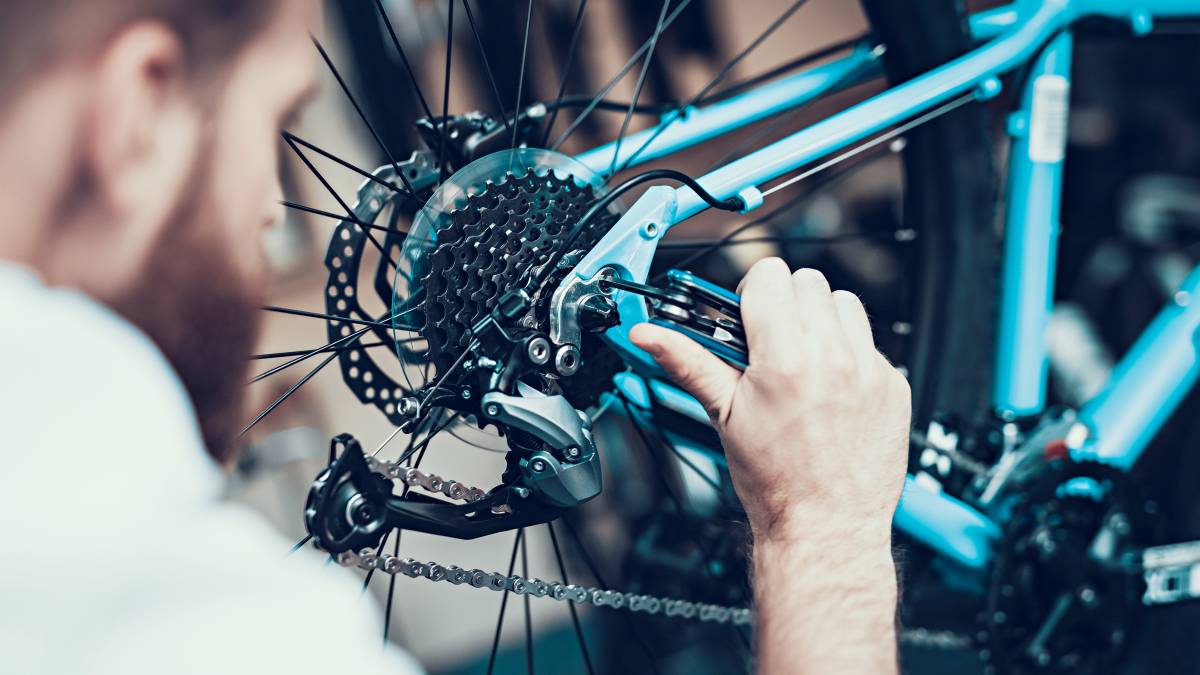
- Home/
- Comparisons/
- Bicycle Service/
- Organic vs Sintered Brake Pads
Organic vs sintered brake pads: Which type do you need?
Compare organic and sintered brake pads in terms of performance, durability, and more.
Published on

Written by Angela A.
Staff Writer
Read more about our contributor
Organic brake pads
Key Facts
Organic brake pads are made from natural materials and provide quiet braking with minimal dust.
Sintered brake pads are made from metal particles fused together, offering superior heat resistance and durability for high-performance applications.
Did you know that your choice of brake pads could mean the difference between a smooth stop and a costly brake failure? Choosing the wrong type of brake pad can lead to poor braking performance, excessive wear, and even safety risks.
But with so many options on the market, how do you know which one is right for your vehicle? Don’t worry. This guide will break down the key differences between organic vs sintered brake pads. By the end, you’ll be able to make an informed decision that ensures optimal performance and safety.
What are organic brake pads?
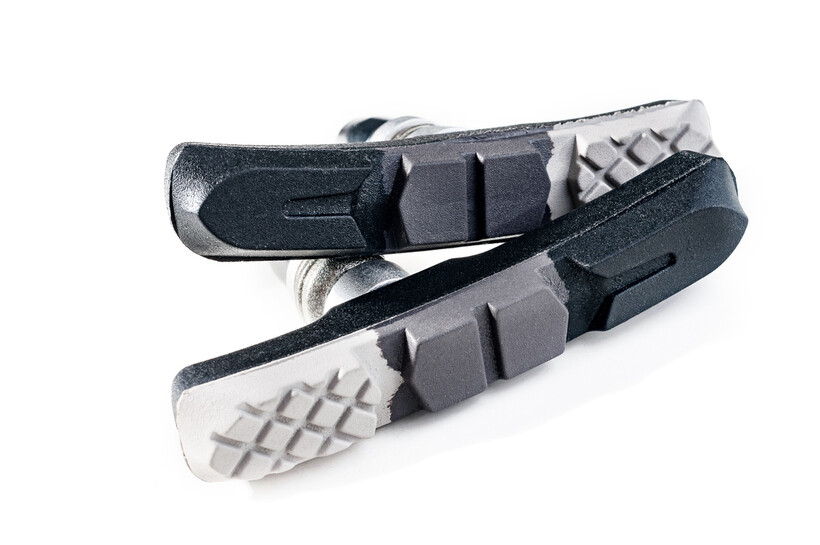 Bicycle organic brake pads with textured grooves. (Source: iStock)
Bicycle organic brake pads with textured grooves. (Source: iStock)
Organic brake pads, often referred to as resin pads, are made from a blend of materials like Kevlar, rubber, and silica, all held together by resin. This combination creates a softer pad that provides a quieter braking experience and a smoother, more progressive feel when you hit the brakes.
They’re a great fit for recreational cyclists or for road cycling in dry weather. They’re also commonly used in mountain biking where extreme braking force isn’t necessary. Plus, they work wonderfully on bikes with polished or chrome-plated rotors, thanks to their gentle impact on the surface.
What are sintered brake pads?
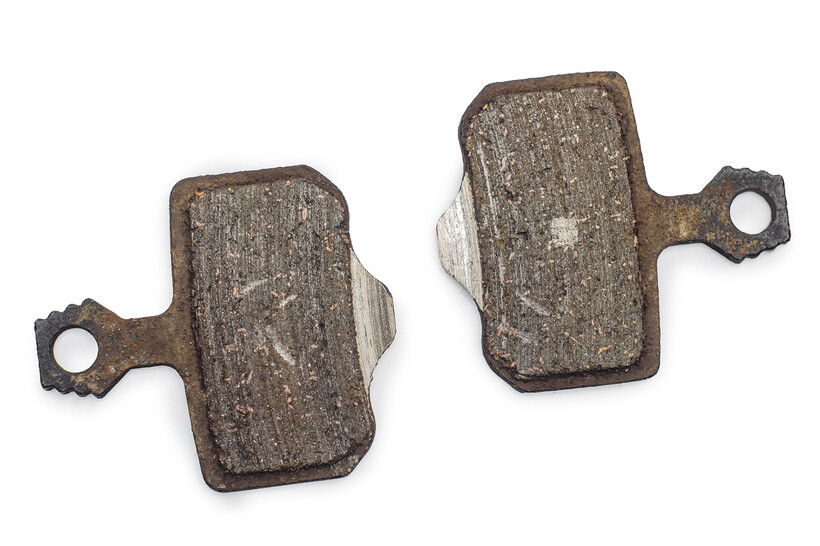 Pair of worn sintered brake pads for a bicycle. (Source: iStock)
Pair of worn sintered brake pads for a bicycle. (Source: iStock)
Sintered brake pads are a popular choice for riders looking for robust performance in challenging conditions. They’re made by sintering, which fuses metallic particles—like copper or iron—under high heat and pressure. This then results in a dense, durable pad.
This composition gives them an edge in durability. They also provide consistent performance, particularly in wet, muddy, or high-temperature situations, making them ideal for downhill and enduro mountain biking or aggressive riding styles.
Sintered vs organic brake pads: What are their key differences?
There are two common types of braking systems: drum and disc brakes. Between them, disc brakes are gaining popularity, especially in mountain biking and road cycling, because of their superior stopping power and control. However, using disc brakes also means choosing the right brake pads, as they create the friction needed to stop your wheels.
So, when it comes to choosing the best MTB brake pads, understanding the differences between sintered and organic brake pad types is crucial. Whether you’re considering motorcycle or bicycle brake pad types, we’ll dig into the key factors that’ll help you navigate this decision.
In terms of initial bite
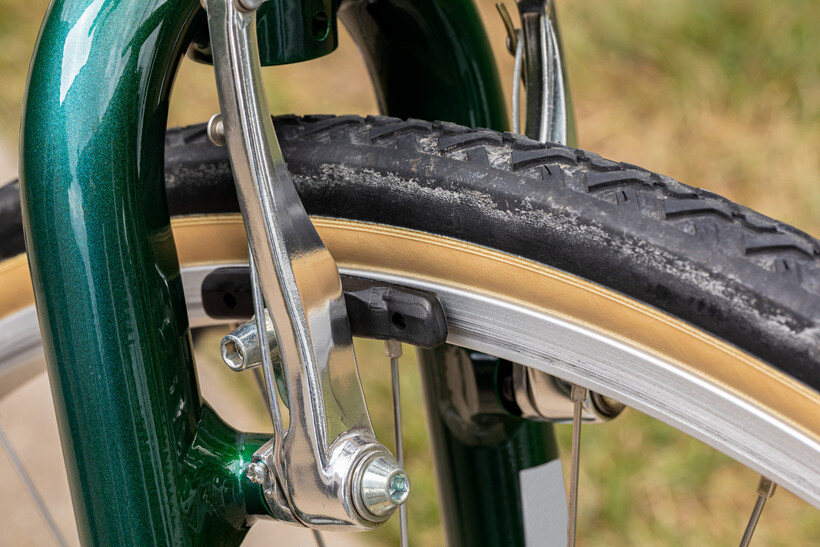 Detail of bike brake pads mounted on a green fork. (Source: iStock)
Detail of bike brake pads mounted on a green fork. (Source: iStock)
Initial bite is the term used to describe how quickly a brake pad starts gripping the rotor. Organic brake pads shine in this area with their sharp and immediate response. They start working right away, giving riders excellent control, especially at lower speeds. This quick engagement also makes them ideal for casual cyclists who need fine modulation in braking.
On the other hand, sintered brake pads have a more gradual initial bite. They often need a short warm-up period to perform at their best. Once warmed up, they provide strong and consistent braking, although their response is not as immediate as that of organic pads.
In terms of braking performance
Braking performance refers to the overall stopping power of a brake pad. This aspect largely depends on the friction coefficient or how effectively the pad can grip the rotor. It’s also one of the areas measured during an MOT test in the UK.
Organic pads excel under dry conditions with their smooth, progressive braking. They offer excellent control at lower speeds. However, they can also fade quickly under high temperatures, which makes them less suitable for intense or prolonged braking scenarios, like in hilly terrain or during aggressive descents.
In contrast, sintered pads shine when the heat is on. They maintain consistent braking power even during strenuous riding, such as downhill mountain biking, where sustained pressure is common. Their durability and performance in wet or muddy conditions also make them a solid choice for varied environments, ensuring reliability in unpredictable weather.
In terms of disc compatibility
 Installing new brake pads on a bike disc rotor. (Source: iStock)
Installing new brake pads on a bike disc rotor. (Source: iStock)
When it comes to disc compatibility, organic brake pads are gentler on rotors. Their softer composition results in less wear, which can extend the lifespan of disc brake pads. They’re compatible with all disc types as well, including polished or chrome-plated rotors. This makes them a versatile option for road bikes and mountain bikes alike.
On the flip side, sintered brake pads are more abrasive and can lead to increased rotor wear over time. This wear is especially pronounced when paired with rotors not designed for harsher compositions. So, it’s important to match sintered pads with compatible rotors to avoid premature wear and damage.
Additionally, sintered pads transfer more heat to the disc, which can impact the rotor’s longevity and performance if not managed properly. This makes them better suited for more demanding conditions, but riders must ensure their rotors can tolerate this added stress. Balancing performance and rotor preservation is key for optimal braking in any biking scenario.
In terms of noise and vibration
Organic brake pads are notably quieter during braking, thanks to their softer material. They produce less noise, especially when cold or during light braking. Additionally, their design reduces vibration, resulting in a smoother and more comfortable experience.
Meanwhile, sintered brake pads tend to be louder. They produce a characteristic squeal or grinding noise, particularly when cold or during initial stops. Their harder composition can lead to increased vibration, too, especially under heavy braking. Furthermore, in wet or muddy conditions, sintered pads can generate more noise due to the metal particles interacting with moisture.
For those considering alternatives, semi-metallic brake pads sit between organic and sintered options. They offer decent noise reduction while providing slightly better performance than organic pads. However, riders should be aware that they may still not completely eliminate the noise common with sintered pads.
In terms of durability and wear resistance
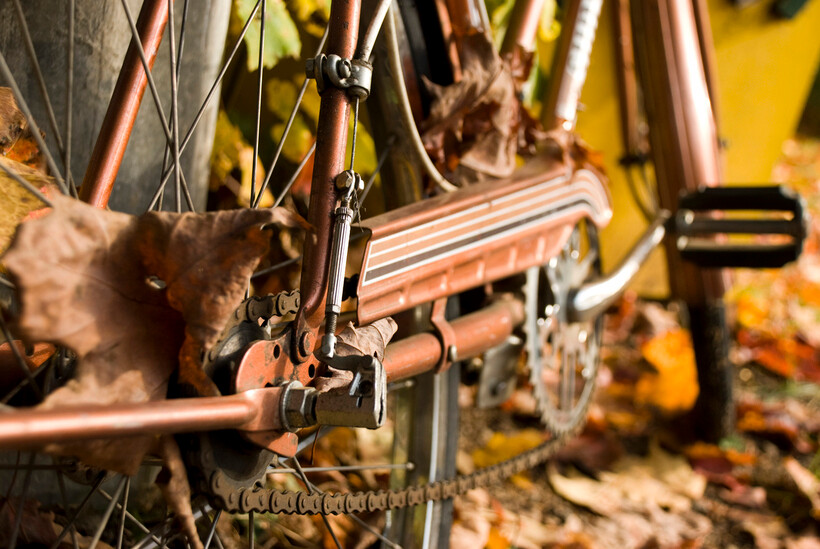 Worn brake pads on an old bike surrounded by leaves. (Source: iStock)
Worn brake pads on an old bike surrounded by leaves. (Source: iStock)
When considering brake pad replacement, the differences between organic and sintered pads become quite clear in terms of durability.
Organic brake pads typically have a shorter lifespan because they’re made from softer materials that wear out faster, especially in tough conditions. They’re not ideal for harsh environments—like wet, muddy, or sandy terrain—where they degrade more quickly and are prone to glazing under high temperatures.
On the other hand, sintered pads are made from hard metallic materials that offer a longer lifespan and greater wear resistance. This makes them suitable for all weather conditions, from rain to heat, without compromising performance.
Some also compare organic vs metallic brake pads in terms of durability. However, as semi-metallic sintered pads combine the best of both worlds, it’s wise to consider them as a viable middle ground.
In terms of cost
Organic brake pads are typically cheaper, ranging from £7 to £25. This lower price reflects their quicker wear and shorter lifespan, though. While they might seem budget-friendly at first, frequent replacement can add up over time, particularly for active riders or those in tough conditions.
Sintered brake pads generally cost between £12 and £35. Although they require a larger upfront investment, their durability and longer lifespan can lead to savings in the long run. For serious cyclists who ride in demanding environments, spending a bit more initially can be worthwhile for reliability and performance gains.
It’s also wise to consider the costs of servicing a bike if you ever run into problems with your brakes. It’s better to invest in a higher-quality brake pad from the start than having to constantly replace or repair it.
Upgrade your brake pads with Airtasker
When it comes to ensuring your vehicle’s performance, the choice of brake pads can make all the difference. You’re investing in durability and reliability, especially if you often encounter demanding riding conditions.
But remember, even the best brake pads need regular maintenance to keep them functioning at their best. Fortunately, you can easily post a task on Airtasker and connect with skilled professionals who can assist with everything from bike servicing to mobile bike repairs. You can even find a motorcycle mechanic if needed.
So, whether you’re looking to upgrade your brake pads or need some routine maintenance, why not let the experts handle it? Post a task today and connect with Taskers ready to help you get back on the trails safely and smoothly!
Learn more about our contributors

Written by Angela A.
Staff Writer
Angela Apolonio is an experienced writer with a Biology background. She writes about home tips, car upkeep, gardening hacks, and food facts, bringing a unique blend of science and practicality to her work. As a wife and a mother, she knows the value of iron-clad routines, so she's passionate about sharing what works for her with everyone else. She loves making everyday life simpler and helping readers find fresh ideas to bring more joy into their spaces.
Organic vs Sintered Brake Pads
Organic Brake Pads |
Sintered Brake Pads |
|
|---|---|---|
Initial Bite |
Quick and sharp response, ideal for immediate braking |
Gradual response, needs a short warm-up period |
Braking Performance |
Smooth, progressive braking, best in dry conditions |
Consistent braking, excels in wet and high-temperature conditions |
Disc Compatibility |
Gentler on rotors, less wear |
More abrasive, can cause increased rotor wear |
Noise and Vibration |
Quieter with less vibration |
Tends to be louder with more vibration |
Durability and Wear Resistance |
Shorter lifespan, wears out faster in tough conditions |
Longer lifespan, highly durable in all conditions |
Cost |
Typically cheaper, but may need frequent replacements |
Higher initial cost, but longer-lasting |
FAQs on organic and sintered brake pads
Resin pads are quieter and offer a smoother feel, so they’re ideal for dry conditions. Meanwhile, sintered pads are more durable and better suited for wet or aggressive riding environments.
Yes, brake pads create friction against the brake discs (rotors) to slow down or stop the vehicle. The discs are the rotating components that the pads clamp onto.
You can check the thickness of the brake pads through the calliper. If they are less than 3mm thick, or if you hear squealing or notice increased stopping distances, it’s time for replacement.
Yes, worn brake pads can lead to an MOT failure as they are crucial for safe braking. The test checks their condition and thickness.
Find bicycle service experts, fast
Post a task
Related price guides
